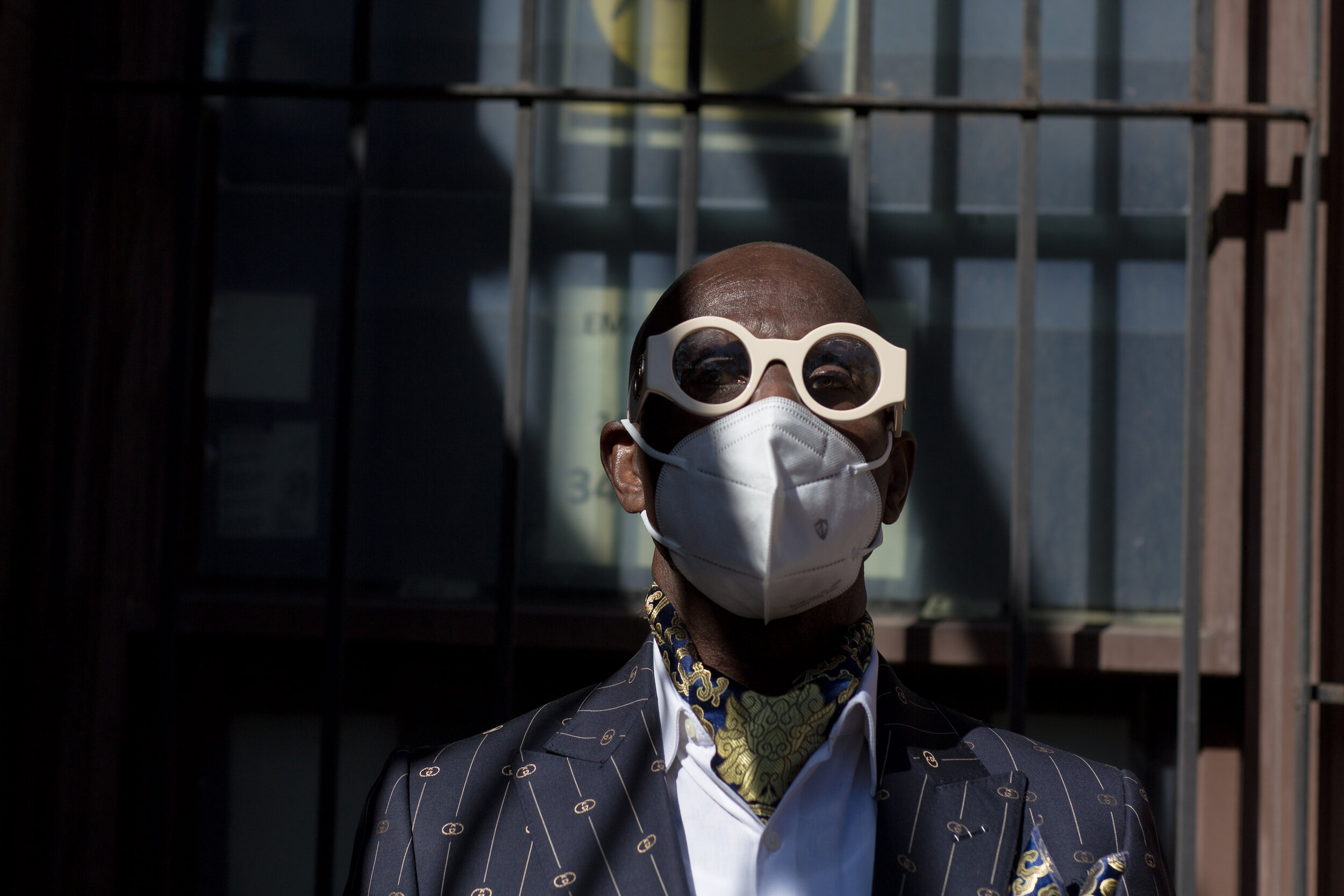TIME’s 100 Honoree Dapper Dan Is “Blackenizing” Fashion With Symbolism And Gucci
By Cassell Ferere originally published on Forbes.com
A man of symbolism, he is the embodiment of Harlem, New York. Dapper Dan, fashion designer and haberdasher, the Father of Logomania, and now one of TIME’s 100 most influential people of 2020 honoree, has always created with intent. He has crafted a purposeful style that contributes enlightenment to those in his presence.
Dan believes he still "hasn’t achieved anything yet,” and the TIME honor is “just a moment” on a path to preserve the Black culture. His goal is to educate the generations of those disenfranchised behind him.
Dapper Dan in front of his Gucci Atelier in Harlem.
CASSELL FERERE, CASSELL INC.
He is a sight to see, “Dap,” as close friends call him, absorbing the aura of the Harlem community, in a tailor-made suit, equipped with a standard N95 facemask. Standing in front of the brownstone he built with the help of Gucci, he greets the neighborhood passers-by as if he were running for political office.
Dapper Dan is known for his logo design and textile printing, which he fabricated himself to resemble high-end European fashion houses, like Louis Vuitton, Fendi, MCM, and Gucci. In the 1980s, his first wave of customers were hustlers and local drug dealers. But over time, young Black celebrities and athletes, like Mike Tyson, and New York City’s entertainers, like LL Cool J and Rakim, became his clients.
It was good business - and he got it, opening his boutique in 1982. But the karma Dan has always been cautious of would slow his business repeatedly. Raids and confiscation by law enforcement of his illustrious garments would shut down his retail business regularly, but not his spirit.
This karma has come back around, stitching a Gucci Atelier collaborative business deal in 2017. A life once lived by Dapper Dan can only be accredited to the man we are familiar with today. He is a symbol of Black entrepreneurship and culture for the fashion world and communities like Harlem.
Migrating Through Harlem
Dapper Dan is a product of the Great Migration from the South. His mother moved from South Carolina and his Dad from Virginia, and Dan was born a first-generation Harlem-American as Daniel Day. Growing up in the East Harlem neighborhood in the 1950s served a more diverse residential but poor class of people. Harlem consisted of the majority of poor Blacks, Italians, Irish, and Puerto Ricans, who all lived scattered throughout the community.
“Harlem in the 50s was a village, today it’s a community. There’s a difference - a village is more cohesive, people are more united. I grew up in the village of Harlem. Now we have the community of Harlem where it’s more diverse and people don’t say ‘hi.’ Harlem used to be like an African village,” Dan explains.
Growing up with holes in his shoes, Dan spent summers by the Harlem River, where he would swim with best friends who were Italian, Irish, Puerto Rican, and Black. Always cautious, he and his friends would toss a Popsicle stick into the flowing river to figure out how strong the current was before jumping in.
It was this current that took Dan through the impoverished streets of Harlem as an adolescent. “I didn’t like being poor. The hustlers - the people in the streets - were most impressive. So, from them, I learned all the street skills I had,” Dan recalls.
Adolescent Lessons
At 14 years old, he got introduced to gentrification by a report from the second ‘Black’ Borough President, Constance Baker Motley. Dapper Dan read in that report a phrase that he remembers as “urban renewal, negro removal.” That report was the blueprint for gentrification embarking on Harlem. This sentiment sewed a seed in Dan that led him to a lifetime of research and refinement.
Dan always believed a man should be well-dressed. He eventually got involved in the gambling scene, drug trafficking, and gaining a reputation as a neighborhood dandy. He received his “Dapper” nickname as his popularity grew in the streets of Harlem. He was earning respect from some of the biggest influencers in town.
Dan would run into the law at 19 years old and served a short jail sentence from June 19, 1967, to September 27, 1967. During his time there, he would be introduced to the Nation Of Islam, ironically by one of the alleged murderers of Malcolm X. Although interested in the knowledge the curriculum provided, he was reluctant to conform, like Dan’s brother did during that time. The organization ultimately inspired the idea of symbolism for Dan.
When released from jail, Dan had a spiritual intervention and couldn’t see himself selling drugs once again. More importantly, he refused to partake in something that he felt directly harmed his community. Fearful of the karma, “Dapper” Dan was finding himself.
‘Fences’ Not Walls
He returned to his success within the gambling economy. Seizing the opportunity, he began to cater to the sartorial needs of the hustlers and drug dealers he often won money from. Dapper Dan’s first stitch into fashion was in the 60s where he found work as a ”Fence” for “Boosters.”
Boosters would travel downtown in New York City to high-end department stores to shoplift trendy fashion styles. They would then bring the clothing back uptown to Harlem, where Dan - the “Fence” - would purchase the goods at 25% of the tag price. He then sold them to the gangsters in Harlem for 50% off the tag price.
Dan would later become a driver for the Boosters earning extra cash on top of his usual rates. Although making money, he had deeper aspirations as a scholar. The money Dan saved funded his education, which was most important to him. Between his hustles, he would enroll in education programs around his community.
He enrolled in the Urban League Program at a local church. Urban League provided an education curriculum for those living in the Harlem community in association with the Allah School of Mecca in Harlem. With beliefs comparable to the Nation of Islam, the program also had an affiliation with the “Five-Percent Nation” [Five Percenters] cultural organization.
Dapper Dan further educated himself at another community organization, The Street Academies, where the kids would partake in accelerated programs to catch-up with their white classmates.
Discouraged by what he would see daily in Harlem, Dan evolved into a revolutionary. He remembered what he read about gentrification at the tender age of 14, and found an opportunity to express his thoughts on his environment…
HOW DO YOU FEEL ABOUT FASHION?
COMMENT OR TAKE OUR PAGE READER SURVEY
Featured









Water management plays an essential role in maintaining the safety and stability of a home.